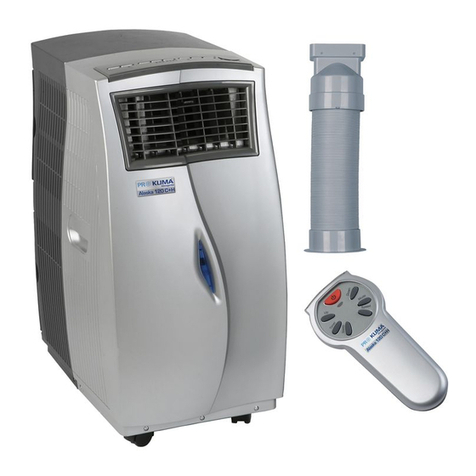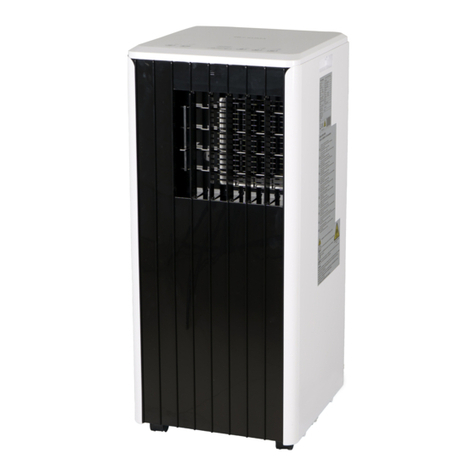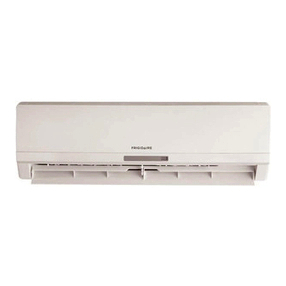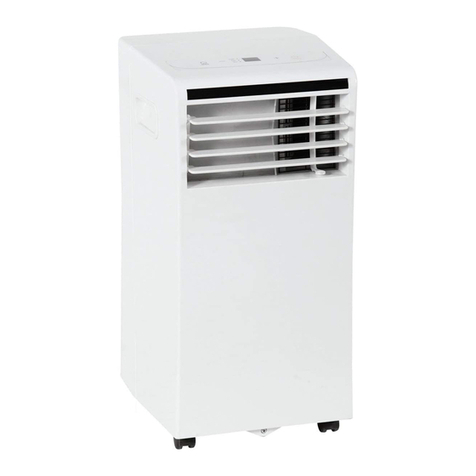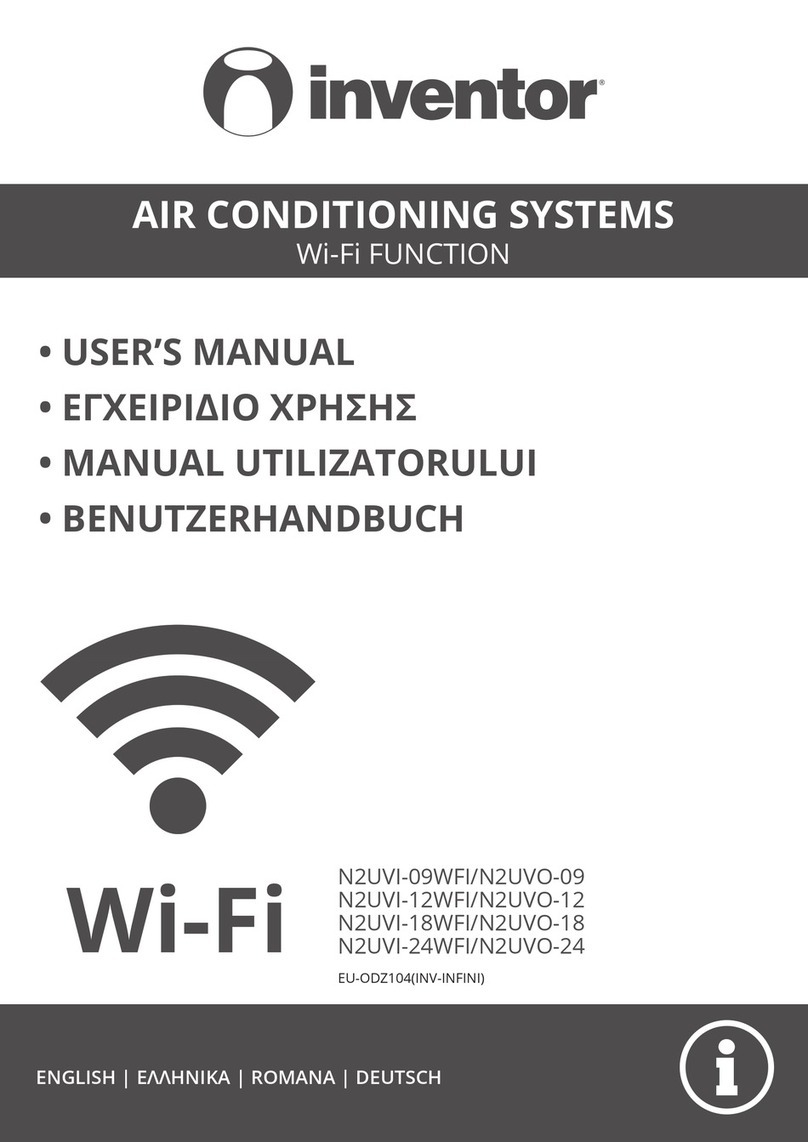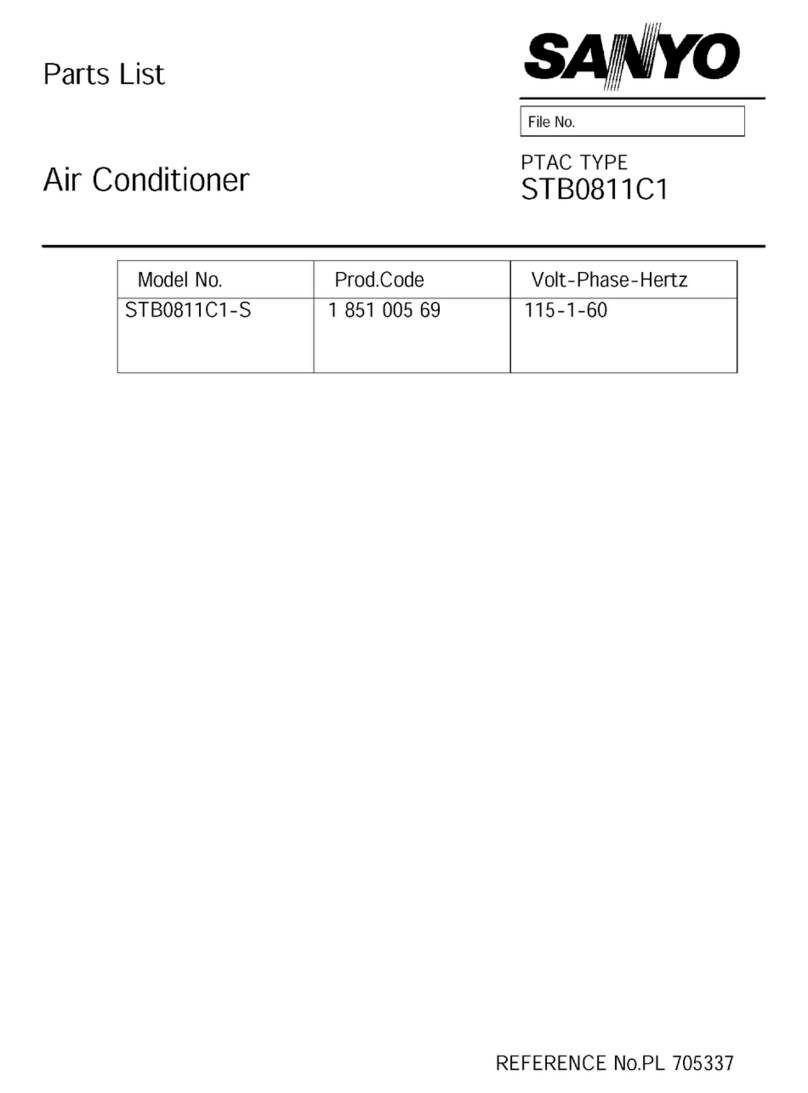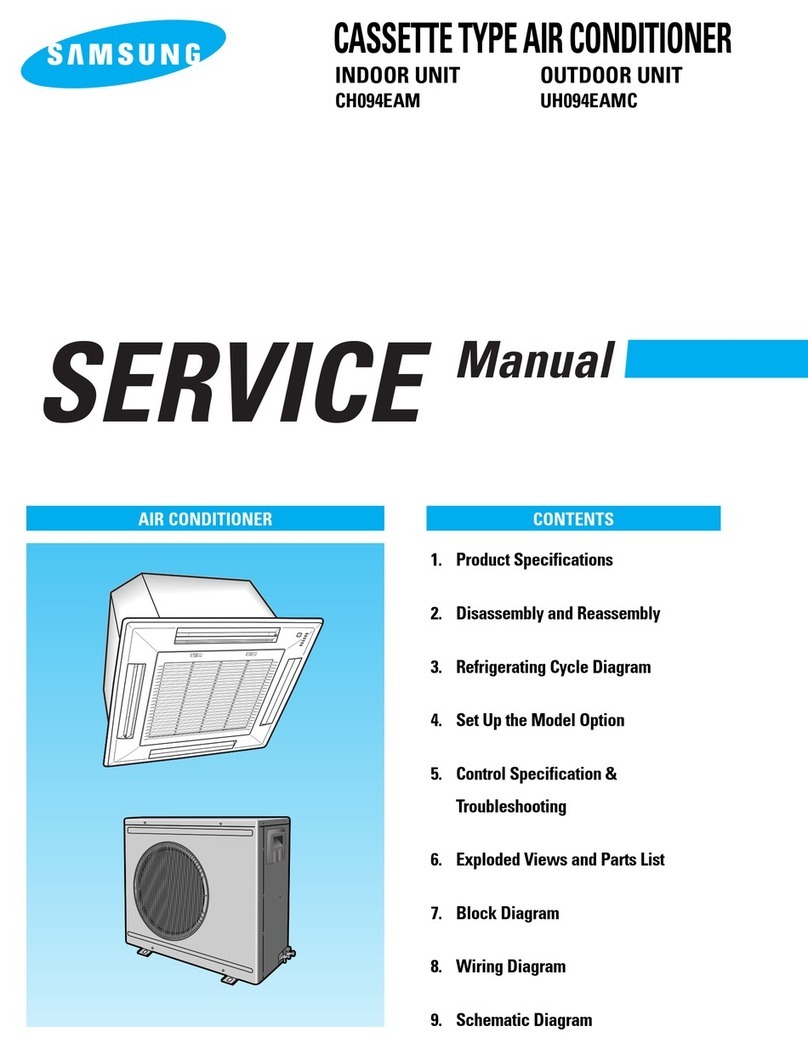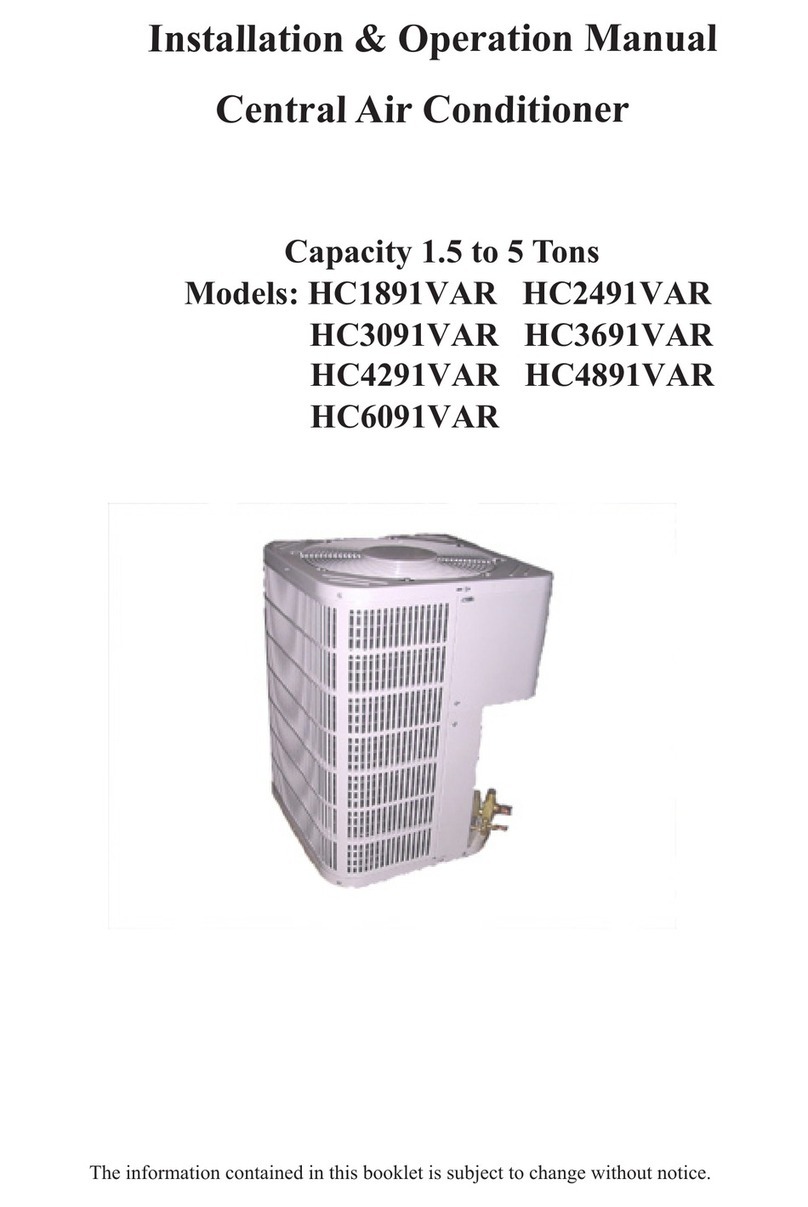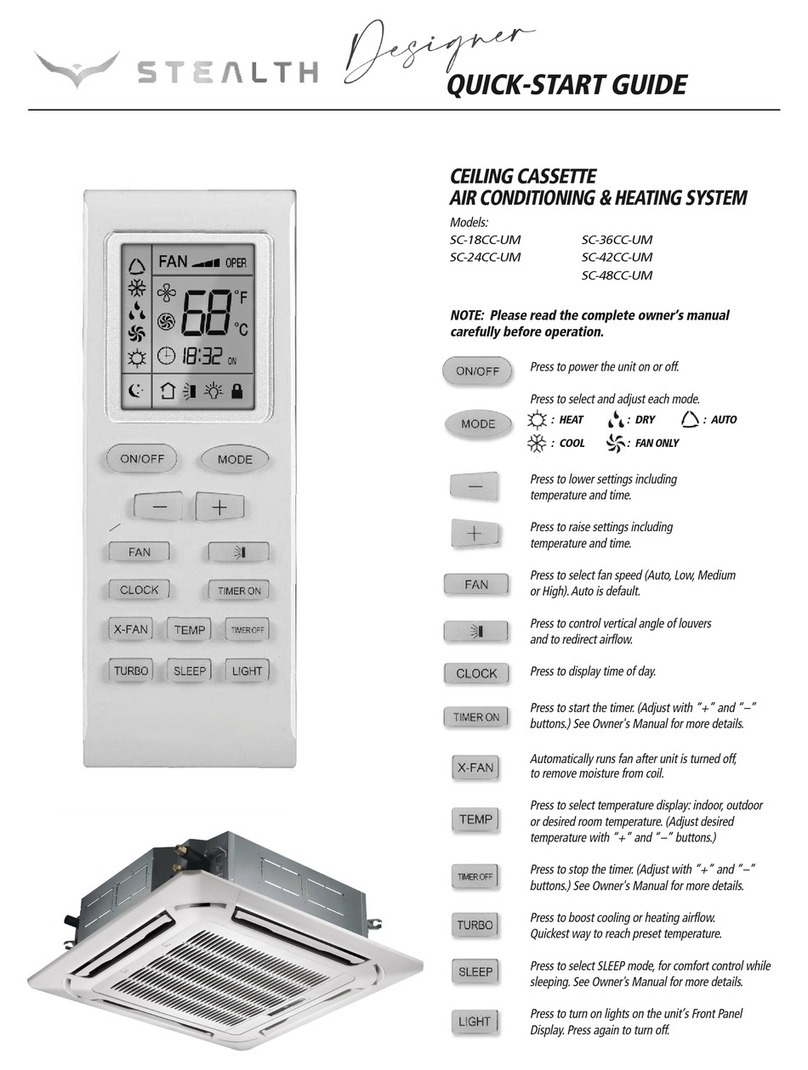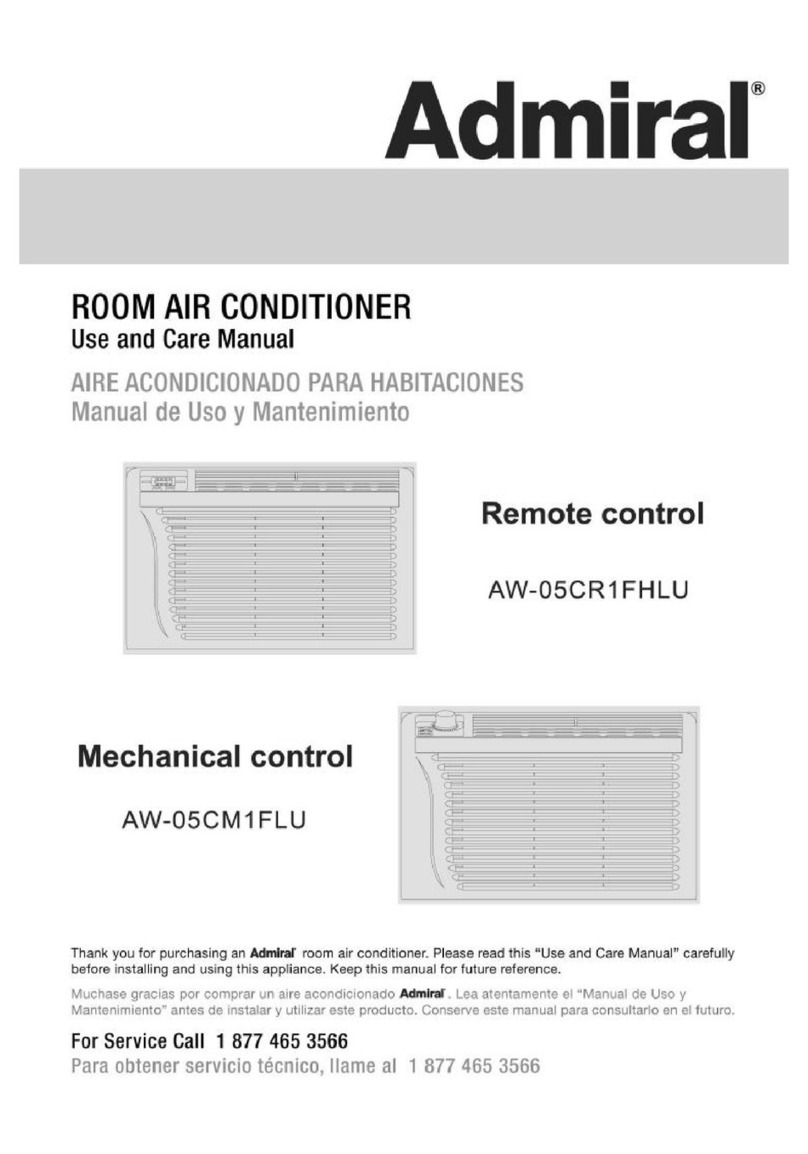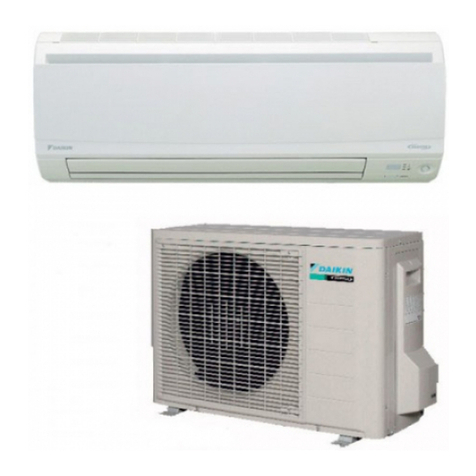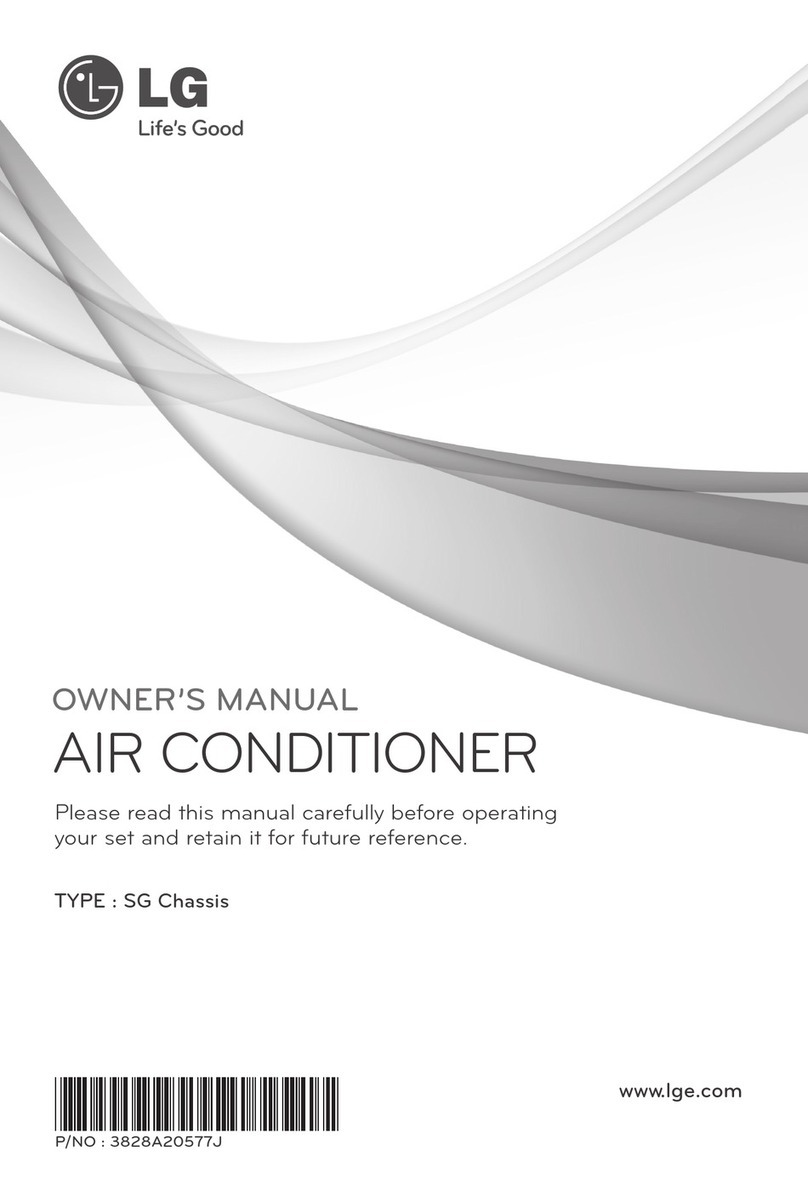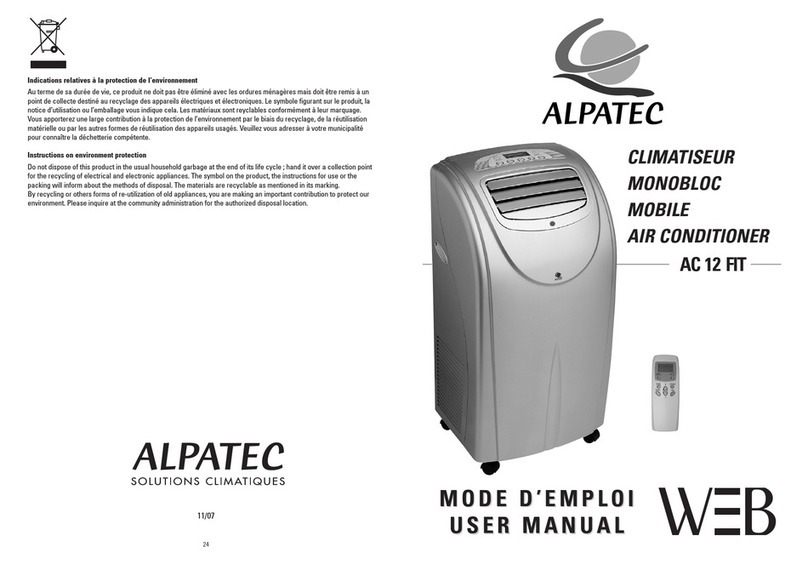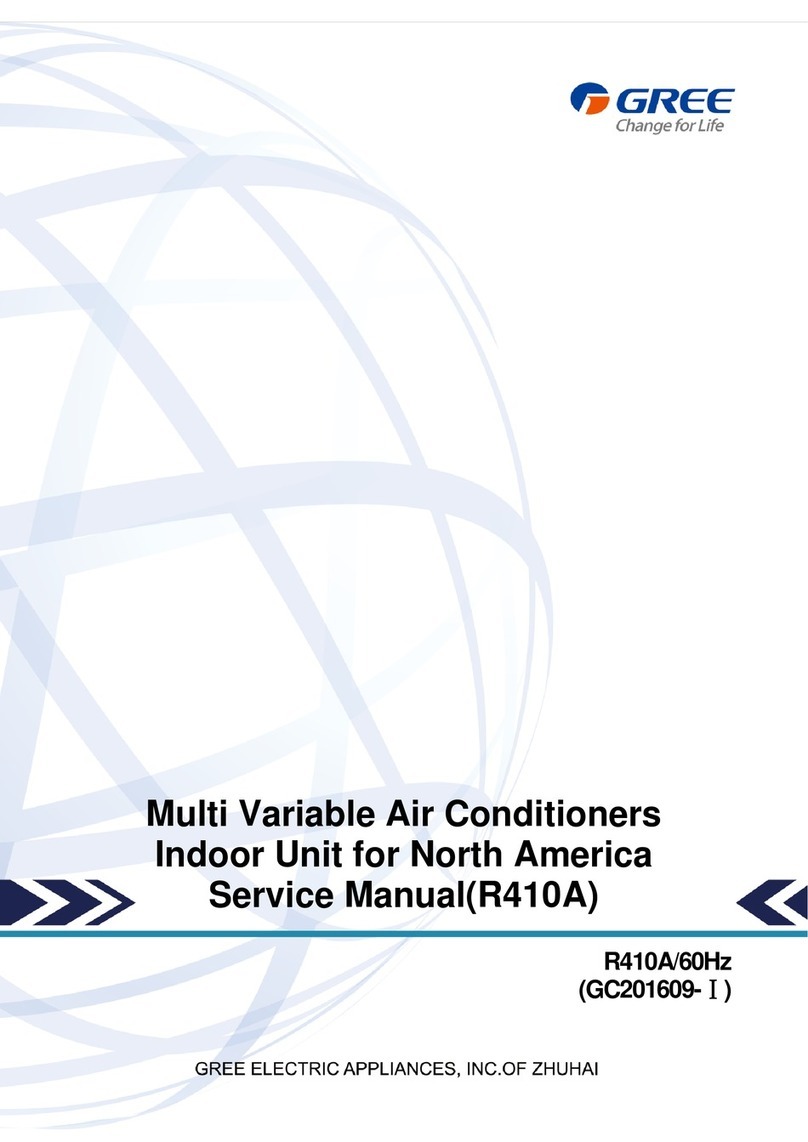ProKlima 23.651.66 User manual

tOperating Instructions for the
Indoor and Outdoor Device
Split-system Air Conditioner
Important note:
This high-quality product will only offer
optimum service if installed correctly and in
the right place, and is put into operation for
the first time by a suitably competent person.
Avoid malfunctions by seeking competent
advice from an expert with regards to the
location, installation and starting up of the
system.
We shall accept no liability for malfunctions
or inadequate cooling performance resulting
from the improper handling of the product.
Only a suitably qualified firm is permitted to
undertake any work of making the electrical
and cooling system connections and putting
the system into operation for the first time.
If the system is to be moved to another
location or disposed of, only a suitably
qualified electricianʼs/cooling system firm is
permitted to undertake any work of
disassembly or disposal.
SPLIT 850 C
Art.-Nr.: 23.651.66 I.-Nr.: 01028
Anleitung_Split_850_C_GB:_ 27.02.2008 15:25 Uhr Seite 1

2
2 3
12
1
34
5
7
6
8
1
3
4
5
10
9
2
89
7
6
Anleitung_Split_850_C_GB:_ 27.02.2008 15:25 Uhr Seite 2

3
5
6
4
8
7
9
10
12 13
11
Anleitung_Split_850_C_GB:_ 27.02.2008 15:26 Uhr Seite 3

4
1110
12
13 14
AB
Ø 65 Ø 65
> 150 mm > 150 mm
Anleitung_Split_850_C_GB:_ 27.02.2008 15:26 Uhr Seite 4

5
15
17 18
19
16
B
D
A
C
20
PE
Anleitung_Split_850_C_GB:_ 27.02.2008 15:26 Uhr Seite 5

6
21
PE
Anleitung_Split_850_C_GB:_ 27.02.2008 15:26 Uhr Seite 6

7
Table of contents
For the user and expert
1. Safety regulations
2. Items supplied
3. Technical data
4. Intended use
5. Description of parts
6. Remote control display
7. Setting up the remote control
8. Description of the remote control functions
9. Indoor device settings
10. Cleaning notes
11. General notes
12. Troubleshooting
For the expert only
13. Installation accessories
14. Installation instructions
15. Evacuation
16. Initial startup
17. Ordering replacement parts
GB
Anleitung_Split_850_C_GB:_ 27.02.2008 15:26 Uhr Seite 7

Important!
When using the equipment, a few safety precautions
must be observed to avoid injuries and damage.
Please read the complete operating instructions and
safety regulations with due care. Keep this manual in
a safe place, so that the information is available at all
times. If you give the equipment to any other person,
hand over these operating instructions and safety
regulations as well. We cannot accept any liability for
damage or accidents which arise due to a failure to
follow these instructions and the safety instructions.
1. Safety instructions
앬Read the safety instructions before you start to
use the device.
앬These points set out extremely important
precautionary measures that you must comply
with.
앬Keep the Operating Instructions in a safe place
once you have read them.
앬Check that the drainage line is correctly
connected. If not, water will escape.
앬Warning!
Do not extend the cable and never use multiple
plugs. A poor electrical connection, poor
insulation or voltage which is higher than
permitted can cause fire.
앬Remove all dirt from the power plug and plug
it in firmly. Soiled plugs can cause fire or an
electric shock.
앬Warning!
앬Never pull out the plug while the device is in use.
앬Never permit cool air to be blown directly at you
for any lengthy period of time.
앬In the event of any abnormalities (e.g. smell of
burning), immediately switch off the device and
pull the plug. Contact your service partner.
앬Never poke fingers or sticks in the air inlet and
outlet vents.
앬Never attempt to repair the air conditioner
yourself. Always contact your service partner if it
requires repair.
앬Never pull the plug out by pulling on the cable.
Hold the plug firmly and pull it out of the plug
socket, otherwise there is a risk of damaging the
cable.
앬Always switch off the device and pull the plug
before you start to clean it.
앬Never actuate any switches with wet hands.
앬Never clean the air conditioner with water.
앬Never place any plants or animals under a
location to which cool air flows as this could have
an undesirable affect on them.
앬Never use combustible cleaning agents as these
could cause a fire or deformation.
앬If the air conditioner is to be used in conjunction
with other heaters, the air should be refreshed
periodically, otherwise there is a risk of lack of
oxygen.
앬Never use the device for any other purpose than
the intended use. Never place food, precision
instruments, plants, animals, paint, etc. on the
device.
앬Never hold any burning objects close to the
device if they could be directly affected by the
emitted air.
앬Always pull out the power plug if the device is not
going to be used for any lengthy period of time.
Collections of dust can cause fire.
앬Never step onto the outdoor device and never
place anything on it.
앬Never use an unsteady or rusty base.
앬Never allow the device to run for too long with the
doors or windows open, or if the humidity is very
high. If the air conditioner runs for a long time in
cooling mode and the humidity is high (over
80%), condensed water may drip out of the
device.
앬Never stand on an unsteady base when you
remove the device from the holder on the wall.
앬Check that the condensation water can run off
unhindered. Water damage can result if the
condensation water cannot run off properly.
앬Never touch any metal parts on the indoor device
when removing the air filter. You may injure
yourself.
앬Never install the device in a room in which
combustible gases can be emitted. Emitted
gases may collect and cause an explosion.
앬Always switch off the device and pull out the
power plug during a storm. Electrical parts may
get damaged.
앬Earthing connection!
The power cable (plug) comes with an earthing
wire. Do not, therefore, change the plug.
앬For electrical safety purposes we recommend
that you install an earth-leakage circuit-breaker.
앬Have all electrical installation work performed by
a qualified electrician.
앬Ask a service partner or specialist cooling system
firm to undertake all work of cooling system-
related installation.
앬Incorrect installation may cause injury or damage
to the device.
앬Check the mains lead at regular intervals for
signs of defects or damage. A damaged mains
lead may only be replaced by an electrician or
ISC GmbH in compliance with the relevant
regulations.
GB
8
Anleitung_Split_850_C_GB:_ 27.02.2008 15:26 Uhr Seite 8

GB
9
앬The equipment is not designed for installation in
laundries.
앬The equipment must be positioned in such a way
that the mains plug is accessible at all times.
앬The temperature in the cooling circuit may
become very hot. For this reason keep all cables
away from the copper lines.
CAUTION!
Read all safety regulations and instructions.
Any errors made in following the safety regulations
and instructions may result in an electric shock, fire
and/or serious injury.
Keep all safety regulations and instructions in a
safe place for future use.
Packaging:
The unit is supplied in packaging to prevent it from
being damaged in transit. The raw materials in this
packaging can be reused or recycled.
Tips on saving energy
Only use the air conditioner when you really need to.
Do not select too high a temperature for heating or
too low a temperature for cooling. Select the “Sleep”
function during the night.
Close all windows, doors and Venetian blinds in
order to reduce incoming sunlight as far as possible.
Principle of operation for cooling
Heat is extracted from the air in the room by the air
heat-exchanger (evaporator) in which the coolant
circulates. This air is conveyed to the outside air
heat-exchanger (condenser).
This gives off heat to the outdoor air. Electrical
energy is required for this. In certain circumstances
condensation may form on the evaporator on the
indoor unit, which will be removed by the
condensation hose.
2. Items supplied
1 indoor device (box 1, art. no. 23.653.96)
1 outdoor device (box 2, art. no. 23.653.97)
1 set of installation accessories (for details,
see page 15)
3. Technical data
Cooling capacity 2500 watts
Heating capacity - watts
Energy efficiency D (EER 2.62)
Air capacity 420 m3/h
Absorbed humidity (30°C/80% RH) 1.0 l/h
Timer 24 h
Operating voltage 230 V ~ 50 Hz
Socket fusing 10 A
Nominal power consumption, cooling 1150 watts
Nominal current consumption, cooling 4.6 A
Nominal power consumption, heating - watts
Nominal current consumption, heating - A
Compressor Rotary piston
Compressor starting current 23 A
Outdoor temperature -15 - +46°C
Indoor temperature +16 - + 30°C
Fluid line Ø A 6.35 mm
Suction pipe Ø A 9.53 mm
Length of refrigerant line supplied 4 m
Length of refrigerant line, max. 10 m
Max. difference in height between indoor/outdoor
device 5 m
Refrigerant R 407 C
Refrigerant filling capacity 500 g
Refrigerant refill quantity from 5 m 20 g/m
Sound pressure level
Inside ≤ 37 dB (A)
Outside ≤ 52 dB (A)
Dimensions
Inside 71 x 18 x 25 cm
Outside 72 x 26 x 43 cm
Weight
Inside 7 kg
Outside 25 kg
Note:
The specified capacities and performances are
based on the following conditions (EN 14511):
Cooling:
Air temperature at the inlet on the indoor device:
27°C for dry thermometer bulb (DB), 19°C for wet
thermometer bulb (WB). Outdoor air temperature:
35°C for dry thermometer bulb (DB), 24°C for wet
thermometer bulb (WB).
Anleitung_Split_850_C_GB:_ 27.02.2008 15:26 Uhr Seite 9

GB
10
Temperature ranges:
Cooling
Room temperature 16°C ~ 30°C
Outdoor temperature > +18°C
Dehumidifying
Room temperature 16°C ~ 30°C
Outdoor temperature > +18°C
Notes:
1. For health reasons the room temperature should
be no more than 5 – 6°C below the outdoor
temperature in cooling mode.
2. The perfect performance of the system is
achieved within the temperature ranges shown in
the table.
3. If the air conditioning system is operated below
the temperature range shown above, protection
functions may be activated in certain
circumstances which will cause the device to
operate abnormally.
4. If the air conditioner is operated in a relative
humidity level of over 80%, condensation may be
deposited on the top of the system which will
then drip on to the floor. In this case set the
horizontal air flap to its maximum angle
(perpendicular to the floor) and set the FAN to
“HIGH”.
4. Intended use
The air conditioner is only designed for cooling,
heating or dehumidifying private homes or
bedrooms.
The machine is to be used only for its prescribed
purpose. Any other use is deemed to be a case of
misuse. The user / operator and not the
manufacturer will be liable for any damage or injuries
of any kind caused as a result of this.
Please note that our equipment has not been
designed for use in commercial, trade or industrial
applications. Our warranty will be voided if the
machine is used in commercial, trade or industrial
businesses or for equivalent purposes.
5. Description of parts (Fig. 1)
1 Front panel
2 Air inlet
3 Air filter
4 Air outlet
5 Horizontal air flow grille
6 Vertical air slit
7 Remote control
8 Refrigerant line, condensate hose
9 Air inlet
10 Air outlet
6. Remote control display
Explanation of “MODE” display
AUTO = Automatic
COOL = Cooling
DRY = Dehumidifying
FAN = Fan function
Explanation of “FAN” display
Auto = Automatic fan speed
Low Fan = low fan speed
Middle Fan = middle fan speed
High Fan = high fan speed
7. Setting up the remote control
Insert batteries
1. Open the battery compartment cover.
2. Insert two new batteries. Be sure to observe the
correct polarity (+/-) of the batteries.
3. Close the battery compartment cover.
Notes
앬The radio signal has a range of approx. 8 m.
앬Use two alkali batteries, type R03 AAA (1.5 V).
앬Always replace both batteries at once when you
can no longer see the LCD display.
앬Never use a combination of new and used
batteries.
앬Never use a battery type other than the specified
one.
앬If the remote control is not used for a lengthy
period of time, remove the batteries to prevent
them leaking.
앬The service life of the batteries if the remote
control is used normally is approximately 12
months.
앬Dispose of spent batteries properly.
Notes
Keep the remote control approximately 1 m from
television sets or other electrical appliances. Direct
sunlight may considerably reduce the range of the
remote control.
Objects between the remote control and the IR
Anleitung_Split_850_C_GB:_ 27.02.2008 15:26 Uhr Seite 10

GB
11
receiver which can impede reception of the signal
must be avoided. Handle the remote control with
care. Do not drop it, keep it away from heat and
moisture so as not to damage the remote control.
8. Description of the remote control
functions (Fig. 2-4)
Button assignment
1. ON/OFF: Pressing this button enables you to
switch on the device. Pressing it a second time
will switch off the device.
2. MODE: Pressing this button allows you to select
the mode for the device. The mode will change
each time you press the button in the following
sequence: AUTO – COOL – DRY – FAN.
3. +: Pressing this button increases the temperature
set for the room.
4. -: Pressing this button reduces the temperature
set for the room.
5. FAN: Pressing this button enables you to select
the fan speed. Each time you press this button
the speed will be switched in the following
sequence:
LOW – MED – HIGH – AUTO.
6. SLEEP: Pressing this button enables you to
select economy mode. Pressing it a second time
will deactivate this mode. The mode is also
deactivated as soon as you press the ON-OFF
button.
7. SWING: Pressing this button will activate the
automatic direction change for the ventilation
flaps. The air flow is adjusted
upwards/downwards.
8. TIMER ON: Pressing this button enables you to
set the time at which the device will switch on. To
deactivate this mode, press the button as often
as required until the TIMER ON indicator
disappears from the display.
9. TIMER OFF: Pressing this button enables you to
set the time at which the device will switch off. To
deactivate this mode, press the button as often
as required until the TIMER OFF indicator
disappears from the display.
10. BLOW: Pressing this button enables you to
activate the Blow function which is designed to
prevent moisture on the heat exchanger in the
indoor device. This function is only available in
DRY and COOL modes.
11. CLOCK: Pressing this button enables you to set
the current time.
12. TURBO: Pressing this button enables you to set
an even higher fan speed to cool or heat the
room more quickly.
13. LIGHT: -
Operating modes
A) Cooling mode
1. Press the “ON/OFF” key to switch on the device.
2. Press the “MODE” key until the “Cooling” mode
icon appears in the display.
3. Press the “Swing” key. The air flow is adjusted
upwards/downwards. Press the key twice to lock
the slats in their current position.
4. Press the “FAN” key to select the fan speed:
Automatic -> Slow -> Medium -> Fast
5. Press the “+” or “-” key to set the desired
temperature.
Notes!
앬The cooling mode will only work if the room
temperature set is lower than the current room
temperature. When the set room temperature is
reached, the outdoor compressor stops. The
centrifugal fan of the indoor device circulates the
air in the room.
앬The set room temperature should not be more
than 5°C below the outdoor temperature
(example: outdoor temperature 30°C, ideal room
temperature 25°C).
앬The room temperature can be set between 16°C
and 30°C with the remote control.
앬The higher the outdoor temperature, the higher
the attainable indoor temperature
B) Dehumidifying mode
1. Press the “ON/OFF” key to switch on the device.
2. Press the “MODE” key until the “Dehumidifying”
mode icon appears in the display.
3. Press the “Swing” key. The air flow is adjusted
upwards/downwards. Press the key twice to lock
the slats in their current position.
4. Press the “+” or “-” key to set the desired
temperature.
Notes!
앬The room temperature can be set between 16°C
and 30°C with the remote control.
C) Automatic mode
1. Press the “ON/OFF” key to switch on the device.
2. Press the “MODE” key until the “Automatic” mode
icon appears in the display.
3. Press the “FAN” key to select the fan speed:
Automatic -> Slow -> Medium -> Fast
D) Sleep function
1. Press the “ON/OFF” key to switch on the device.
2. Press the “MODE” key until the “Cooling” or
“Dehumidifying” mode icon appears in the display.
Anleitung_Split_850_C_GB:_ 27.02.2008 15:26 Uhr Seite 11

GB
12
3. Press the “Swing” key. The air flow is adjusted
upwards/downwards. Press the key twice to lock
the slats in their current position.
4. Press the “FAN” key to select the fan speed:
Automatic -> Slow -> Medium -> Fast
5. Press the “+” or “-” key to set the desired
temperature.
6. Press the “Sleep” key to activate the sleep
function.
Notes!
앬If the cooling or dehumidifying mode is set in
conjunction with the sleep function, the set room
temperature increases (1°C during the first hour
and 2°C during the second hour) in order to
prevent overcooling.
E) Timer settings (for automatically switching the
device on/off)
Note:
First of all set the current time using the “Clock”
button.
1. “T-ON / Device ON timer button
This button enables you to switch on the unit
automatically (max. 24 hours). The only requirement
is that the device is connected to a power supply.
Press the “ON / OFF” button to deactivate the
“Device ON timer” again.
2. “T-OFF” / Device OFF timer button
This button enables you to switch off the unit
automatically (max. 24 hours). The only requirement
is that the unit is in operation. Press the “ON / OFF”
button to deactivate the “Device OFF timer” again.
F) Additional functions
BLOW function
This function prevents moisture forming on the heat
exchanger in the indoor unit.
TURBO function
An even higher fan speed will ensure that the
required room temperature is reached more quickly.
LOCK function
Press the “+” and “-” buttons at the same time to lock
and unlock the keypad on your remote control. As
soon as the keypad has been locked, a lock will
appear on the remote control display.
FAHRENHEIT / CELSIUS display
Press the “+” and “-” buttons at the same time whilst
the device is switched off to change the temperature
display from °C to °F or vice versa.
9. Indoor device settings
Setting the vertical air flow direction (Fig. 5)
The left-hand and right-hand side flow directions can
be adjusted manually. Perform these adjustments
before you start the device because once it has been
started the slats vibrate and there is a risk of your
fingers getting caught.
Remote control fails to work (emergency
operation) (Fig. 6)
If the remote control fails to work (empty batteries or
malfunction), use the emergency switch.
앬The device is off: After the emergency stop
switch has been pressed the device switches to
automatic mode. The slat adjuster also operates
in automatic mode.
앬The device is on: The device switches off if the
emergency switch is pressed.
10. Cleaning notes
Important!
Switch the device off and pull the mains plug each
time before cleaning.
Note!
The time intervals at which the device should be
cleaned are a factor of the area of installation. The
time intervals listed below should be maintained in
most cases.
Keep the outdoor device and the area around the
outdoor device clean. Regularly remove leaves, etc.
which can collect around the outdoor device.
Cleaning the housing of the indoor device
앬Clean the housing of the indoor device using
only a soft, wet cloth when necessary.
앬In order to avoid damaging the housing and
electronics, avoid the use of gasoline, thinners,
scouring powder, cleaners and the like when
cleaning.
Cleaning the air filters of the indoor device
Make sure that the air filters are clean! Soiled air
filters reduce the air output of the device. The air
filters of the indoor device should be checked and, if
necessary, cleaned on a monthly basis.
1. Raise the front panel of the indoor device until
Anleitung_Split_850_C_GB:_ 27.02.2008 15:26 Uhr Seite 12

GB
13
the panel audibly clicks into position in its open
position (Fig. 7).
2. Raise the air filter slightly using the handle (Fig.
8) to take the filter out of the filter holder and
then pull it downwards to remove it. Take the air
filter out of the indoor device.
3. Clean the netting in the air filter with a vacuum
cleaner or wash it out with water.
4. Then dry the filter in a cool place.
5. Place the top part of the air filter back into the
device and ensure that its left and right edges
are correctly aligned. Then insert the filter in full
(Fig. 9).
6. Close the front panel again.
Cleaning the heat exchanger of the indoor device
The heat exchanger must be cleaned at least once
annually. To do this, remove the air filters from the
indoor device as described above.
앬Using a vacuum cleaner or a long-bristled brush,
carefully remove any dirt deposits on the heat
exchanger; this will avoid damaging the heat
exchanger fins. A damaged heat exchanger will
lead to higher operating costs.
앬Take steps to ensure that you do not injure
yourself on the fin edges!
11. General notes
Restarting after lengthy non-use
If the air-conditioning system has not been used for a
lengthy period, check the following before you switch
it on:
1. there are no objects covering the outdoor or
indoor unit.
2. the socket from which the unit is operated has
been installed correctly
3. the air filters are clean
Care precautions
If the air conditioner is not going to be used for some
period of time:
1. Let the fans run for 6 hours to allow the device to
completely dry out. Set the highest possible
temperature level while the fans are running.
2. Switch off the device and pull the power plug.
3. Clean the air filters and housing parts.
4. Remove all dirt from the outdoor unit.
5. Take the batteries out of the remote control.
If the following events occur during operation,
they do not constitute a fault.
1. Safety function of the air conditioning system,
compressor trip
After the system has been switched on again,
the compressor will not cut in until after a delay
of three minutes.
2. “White mist” is emitted from the indoor device
If the temperature difference between the air inlet
and air outlet is large and the relative humidity in
the room is also high. “white mist” may be
generated in cool mode.
3. A low noise is emitted by the air conditioning
system
a) When the compressor is running or shortly after
it has been switched off, a hissing noise may be
heard, caused by the refrigerant flowing through
the pipes.
b) When the compressor is running or shortly after
it has been switched off, a “screeching” noise
may be audible, caused by the heat expansion
and cold contraction of the plastic parts in the
device due to temperature changes.
c) The first time the power supply is switched on,
the air flap will return to its initial position.
4. Dust is blown out of the indoor device
a) This is normal if the air conditioning system has
been switched off for a lengthy period of time
and when it is started for the first time.
5. A strange odor emanates from the indoor
device
a) This odor is generated in the indoor device and
is emitted by certain materials or pieces of
furniture or by cigarette smoke.
6. In rooms with high relative humidity (over
80%), water droplet are deposited on the surface
of the indoor device in cool mode
Set the horizontal air flap to the vertical air outlet
position and select a HIGH fan speed.
7. A lightning strike or the mobile phone in a car
in use near the system may cause faults in the
device
In this case disconnect the deviceʼs power supply
briefly and then reconnect it. Press the ON/OFF
button on the remote control to restart the device.
12. Troubleshooting
Device does not start. Check the following:
1. Is voltage present at the plug socket outlet?
2. Check the plug fuse!
3. Is the timer set?
Anleitung_Split_850_C_GB:_ 27.02.2008 15:26 Uhr Seite 13

The device does not provide satisfactory cooling!
Check the following:
1. Has an appropriate temperature been set?
2. Is the air filter soiled? Clean and fit back in place.
3. Are the inlets and outlets on the outdoor device
blocked?
4. Has the sleep mode been set during the day?
5. Are the connections between the indoor and
outdoor device adequately sealed? There may not
be enough coolant? If so, please contact your
service company.
The remote control does not work!
(Important! It only works within a range of 8 m
from the indoor device.)
1. Are the batteries still OK? Replace if necessary!
2. Have the batteries been inserted correctly?
Check that the + and – terminals are correct!
3. Are there any objects between the indoor unit
and the remote control which may interfere with
the signal? Remove these objects.
In the event of a power failure, check the
following:
Press the ON/OFF key after a power failure.
If the problems remain after checking through the
above points, switch off the device and contact your
service company.
GB
14
Anleitung_Split_850_C_GB:_ 27.02.2008 15:26 Uhr Seite 14

GB
15
The following pages are intended for
professional installers.
Important
Do not hesitate to contact our service partners. They
will be able to give you a speedy response to all your
questions so that your system can be installed
correctly.
13. Installation accessories
Before you start to install the devices, please check
that all the installation accessories have been
supplied.
1 mounting plate for the indoor device
1 infrared remote control
2 batteries (type AAA, 1.5 V)
1 condensed water hose (L = 2 m)
1 sealing compound
1 wall hole cap
1 roll of plastic wrapping tape
1 set of refrigerant lines (L = 4 m)
14. Installation instructions (Fig. 10)
Check that the actual mains voltage is the same
as the mains voltage specified on the rating
plate.
앬Use only suitable fastening material.
앬Important. Make sure that there are no electric
cables or other installations (for example water
pipes) near the drill holes.
앬Earth the outdoor device in accordance with
current regulations.
앬The device must have separate protection
against short-circuits.
앬Have all work of electrical installation performed
by an electrician.
앬Ask a service partner or specialist cooling
system firm to undertake all work of installing the
cooling system.
앬Incorrect installation can lead to injury or damage
to property.
앬Always wear ear muffs, goggles and work gloves
when performing work of installation.
Notes on electrical connection!
All electrical connection work must be performed by
a qualified electrician authorized to do so such work
by the applicable electricity supply company. The
system must have separate protection against short-
circuits. Select a suitably large cable cross-section.
The yellow/green wire is to be used as a protective
conductor only and under no circumstances as a
voltage carrying conductor. The fixed electrical
connection of the device must be capable of being
isolated from the mains power supply by a device
with an isolating distance of at least 3 mm (e.g.
circuit-breaker).
Connect the electrical connections of the indoor and
outdoor devices together first and then connect to
the mains power supply. Check first that the entire
system is voltage-free. Secure the system from being
switched on again.
A. Selecting the place of installation
Indoor device
1. The openings for the inlet and outlet air must
never be covered, otherwise the air will not be
distributed throughout the entire room.
2. Install the indoor device in a location which
ensures that the distance through the wall to the
outdoor device is as short as possible.
3. Make sure that the drainage hose does not have
any kinks or upward inclines when you connect it
with the outside.
4. Do not select a location adjacent to a source of
heat, high humidity or inflammable gas.
5. Select a location which is firm enough for
installation so that the device is not subjected to
vibrations.
6. Check that the device has been installed
correctly and exactly.
7. Make sure that there is sufficient space available
for later repair and service work.
8. The device should be installed at a distance of at
least 1 m from all other electrical devices and
installations, e.g. TV, radio, computer, etc.
9. Select a location for the device which is easily
accessible so that the filter can be cleaned or
replaced without difficulty.
10. The maximum distance between the standard
indoor unit and outdoor unit is 4 m. The
maximum possible length of the refrigerant line is
10 m with a maximum height difference of 5 m.
11. Avoid direct sunlight.
Outdoor device
1. Select a location which avoids causing a
nuisance to neighbours from noise and air
emissions from device.
2. Select a location which is sufficiently well
ventilated.
3. Never cover the air inlets and outlets.
Anleitung_Split_850_C_GB:_ 27.02.2008 15:26 Uhr Seite 15

4. The location must be sufficiently firm for
installation and the prevention of vibrations.
5. There must be no risk presented by combustible
gas or gas escaping as a result of corrosion.
6. Check that the device is installed in accordance
with regulations.
7. It should be installed at least 20 cm above the
expected snow line. Snow must not be allowed
to get into the outdoor unit.
8. The wall for installation must be strong and
capable of supporting the weight of the unit.
9. The device must not be exposed to strong gusts
of wind.
10. Make sure that the device is well ventilated and
kept free of dust. Avoid direct exposure to rain
and sunlight.
11. Install on a firm base, avoiding excessive noise
or vibrations.
Important:
The following could cause malfunctions.
Check with your service company in order to
prevent possible malfunctions at a later date.
The following locations should be avoided for
installation:
앬A location where oil (machine oil) is stored.
앬A location where there is a high salt content.
앬A location with numerous sulphurous sources,
e.g. spa zones.
앬A location where radio transmitters or amplifier
aerials, welding equipment or medical equipment
are in use.
앬A location where the outdoor device is exposed
to direct sunlight. If necessary the device must
be protected with a sun-shade. Such a sun-
shade must not interfere with the air flow,
however.
앬A location in the vicinity of heat or steam
generators.
앬A location which is heavily exposed to dust.
앬A location to which the general public have
access.
앬A location with any other unusual characteristics.
Important!
앬The direction in which the air is blown should
correspond with the prevailing direction of the
wind.
앬Never install in locations exposed to aggressive
air.
앬Comply with all specified minimum distances
(see Important notes on installation).
앬The indoor and outdoor devices may only be
installed if they are in a horizontal position
measured using a spirit level. Check this after
you have completed the installation work.
앬Do not kink or compressed the refrigerant lines.
앬All the refrigerant lines, including connectors and
valves must be fitted with diffusion-resistant heat
insulation.
앬Do not remove the protective caps from the
refrigerant lines / connections on the device until
immediately before you connect them.
앬Open refrigerant lines must be protected from
the ingress of moisture by suitable caps or
adhesive tapes.
B. Installing the indoor device
It is imperative that you comply with the installation
instructions.
1. Before you start installation
앬Select the location for the indoor device (follow
the previous notes on selecting the location for
installation).
앬Check that the available mains voltage is the
same as the voltage specified on the rating plate.
앬Fit appropriate insulation, supplied by the
customer, to the coolant tubes.
2. Fitting the mounting plate (Fig. 11/12)
앬The mounting plate for the indoor device must be
fitted horizontally to the wall. In doing so, it is
imperative that you comply with all specified
distances. Mark and drill the holes for fastening
the mounting plate, and then firmly fasten with
dowels and screws. In order to prevent vibrations
on the indoor device, make sure that there are
no gaps between the wall and the mounting
plate.
3. Drilling holes through the walls (Fig. 12/13)
앬Drill the hole through the wall for the lines/hoses
using a 65 mm drill bit, drilling from the inside (A)
to the outside (B) at an angle downwards of
approx. 5°. The ideal positions of the holes
through the walls are shown in Figure 12.
4. Fitting the condensation water drainage hose
(Fig. 14)
앬The drainage water hose must be run to the
outside with a drop. It is imperative that there are
no bends or kinks. The end of the drainage hose
must not be situated in a container of any kind in
which water can collect. Any water held back in
the drainage water hose could lead to water
damage.
앬Slide the additional drainage hose onto the
mounts on the drainage hose already fixed to the
indoor device. Fasten this connection point with
GB
16
Anleitung_Split_850_C_GB:_ 27.02.2008 15:26 Uhr Seite 16

adhesive tape, checking that it is fully sealed as
you do so.
Important note:
The following work must be carried out exclusively by
our service partner or a specialist refrigeration
contractor of your choice.
5. Connecting the refrigerant lines to the indoor
device (Fig. 15)
Route the refrigerant lines from the indoor device to
the outdoor device.
앬Remove the plastic seals on the refrigerant
connection coupling on the indoor device and on
the respective refrigerant line.
앬Fit the gland on the coolant tube straight on the
thread on the indoor device.
앬Screw the first turns of the thread by hand in a
counterclockwise direction.
앬Then use suitably sized open-ended wrenches to
tighten the glands. Please refer to the following
table for the applicable torque. Check the torque
using a torque wrench.
Ø 6,35 mm tube = 15 - 20 Nm
Ø 9,53 mm tube = 31 - 35 Nm
Notes:
앬The top hook (Fig. 16) on the mounting plate
must be securely attached to the rear of the
indoor device. To simplify the connection of the
pipeline, the indoor unit is to be lifted away from
the wall at the bottom using a screwdriver or
similar. After you have connected the pipeline,
remove the screwdriver again and securely
attach the indoor device to the bottom hook (Fig.
16) on the mounting plate.
앬Bend and position the pipeline carefully. (Fig. 17)
앬Both refrigerant lines must be insulated at the
connection points.
앬The condensation drain hose must be connected
below the refrigerant line.
앬It must be ensured that none of the pipes on the
rear of the indoor device leak.
앬It must be ensured that the condensation drain
hose is positioned at the lowest point of the
insulation package. The hose must be separated
from the cables and connection pipe so that no
condensation can run over the cables and pipe.
앬Do not cross the mains cable with other cables.
6. Wrapping the lines/hoses in protective tape
(Fig. 18/19)
앬Please note that the power cable is not to be fed
through to the outside. All tubes, electric cables
and the drainage water hose have to be wrapped
with the supplied protective tape. Depending on
whether the lines are right-hand or left-hand
versions, the corresponding bushing
preparations must be removed from the indoor
device.
앬The package of lines/hoses is to be laid between
the housing of the indoor device and the wall.
Key for Fig. 18
A = Indoor / Outdoor device connection cable
B = Refrigerant line
C = Wrapping tape
D = Condensation drain hose
7. Final installation of indoor device
앬Feed the package of lines/hoses through the
supplied wall passage. Position the wall passage
cap on the wall passage from the outside. Seal
the wall passage against the wall using the
supplied sealing compound.
8. Electrical connection
Important note: All work of making the electrical
connection of the system must be undertaken by an
electrician.
Use only the supplied connection cable or, if it is not
long enough, cable of exactly the same quality.
앬Take the corner cover off the indoor device.
앬Connect the cable to the indoor device as shown
on the connection diagram (Fig. 20).
(PE=yellow and green wire)
C. Installing the outdoor device
It is imperative that you follow the installation
instructions.
1. Before you start installation
앬Select the location for installation (follow the
previous notes on selecting the location).
앬Check that the available mains voltage is the
same as the voltage specified on the rating plate.
앬The maximum possible distance between the
indoor and the outdoor device using the supplied
accessories is 4 m.
앬If the outdoor device is higher than the indoor
device, make sure that a curve is made in the
coolant tube which is lower than the bottom edge
of the indoor device.
2. Installing the outdoor device
앬The outdoor device can be fastened to the
ground or to a wall bracket (e.g. special
accessory Art. No. 23.651.57) with dowels and
screws. To do so, use the holes on the device.
GB
17
Anleitung_Split_850_C_GB:_ 27.02.2008 15:26 Uhr Seite 17

D. Connecting the refrigerant lines
Proceed as described in section B.5 to connect the
refrigerant lines to the outdoor unit. Please read the
following information carefully.
1. Important notes
앬Please make sure that coolant is never allowed
to enter the environment.
앬Improper handling of coolant may be harmful to
health. Always wear work gloves and goggles
when handling coolant.
앬Make sure that the work place is well ventilated
at all times. Smoking is prohibited.
앬The device must never be operated without the
coolant tubes connected, otherwise the device
will be damaged immediately.
앬Ask one of our service partners or a specialist
cooling system firm to connect the coolant lines
and put the system into operation for the first
time.
Important
1. Have all service work performed by a specialist
firm only. Request a copy of our list of service
partners for any such work.
2. If ever the voltage carrying cable between the
indoor device and the outdoor device should be
damaged, contact a specialist firm.
3. If the power cable should ever be damaged,
have it replaced by an electrician.
4. Important note:
a) The maximum length of the coolant line in the
basic version is 4 meters.
b) If the outdoor device is higher than the indoor
device, a curve will be required in the coolant
tube which is positioned below the height of the
indoor device.
Electrical connection (Fig. 21)
Important note: All work of making the electrical
connection of the system must be undertaken by an
electrician.
앬Remove the connection cover on the outdoor
device.
앬Connect the electric cable as shown in the
illustration; take account of the ground terminal
as you do so (PE=yellow and green wire).
앬Ensure that the wire colors on the terminals of
the indoor device comply with those of the
outdoor device.
앬Fit the connection cover back on the outdoor
device
After you have completed the installation of the
device, check its electrical safety.
15. Evacuation
The evacuation procedure may only be carried out
by an authorized expert. Draining refrigerant
damages the environment and is a criminal offence.
16. Initial startup
Initial startup must be performed by an authorized
specialist and documented.
Cool mode
앬Switch on the voltage supply.
앬Switch on the device using the remote control.
앬Adjust the temperature setting to lower than the
current room temperature using the “TEMP”
button.
앬Set “Cool” mode using the “MODE” button.
Please note that the full cooling capacity is not
achieved until the device has been operating for
approx. five minutes.
앬Check all the functions as described in the
operating instructions.
앬Measure and document all the required values
and check the safety functions.
앬Check the condensate line by pouring distilled
water into the condensate tray, ideally using a
long neck bottle.
17. Ordering replacement parts
Please quote the following data when ordering
replacement parts:
앬Type of machine
앬Article number of the machine
앬Identification number of the machine
앬Replacement part number of the part required
For our latest prices and information please go to
www.isc-gmbh.info
GB
18
Anleitung_Split_850_C_GB:_ 27.02.2008 15:26 Uhr Seite 18

19
kerklärt folgende Konformität gemäß EU-Richtlinie
und Normen für Artikel
tdeclares conformity with the EU Directive
and standards marked below for the article
pdéclare la conformité suivante selon la
directive CE et les normes concernant lʼarticle
verklaart de volgende conformiteit in overeen-
stemming met de EU-richtlijn en normen voor
het artikel
mdeclara la siguiente conformidad a tenor de la
directiva y normas de la UE para el artículo
Odeclara a seguinte conformidade de acordo
com a directiva CE e normas para o artigo
Uförklarar följande överensstämmelse enl. EU-
direktiv och standarder för artikeln
qilmoittaa seuraavaa Euroopan unionin direkti-
ivien ja normien mukaista yhdenmukaisuutta
tuotteelle
erklærer herved følgende samsvar med EU-
direktiv og standarder for artikkel
Tзаявляет о соответствии товара
следующим директивам и нормам EC
Bizjavljuje sljedeću uskladjenost s odredbama i
normama EU za artikl.
Qdeclarå urmåtoarea conformitate cu linia direc-
toare CE μi normele valabile pentru articolul.
Zürün ile ilgili olarak AB Yönetmelikleri ve
Normlar∂ gere©ince aμa©∂daki uygunluk aç∂kla
mas∂n∂ sunar.
z‰ËÏÒÓÂÈ ÙËÓ ·ÎfiÏÔ˘ıË Û˘Ìʈӛ· Û‡Ìʈӷ ÌÂ
ÙËÓ √‰ËÁ›· ∂∂ Î·È Ù· ÚfiÙ˘Ô ÁÈ· ÙÔ ÚÔ˚fiÓ
Cdichiara la seguente conformità secondo la
direttiva UE e le norme per lʼarticolo
lattesterer følgende overensstemmelse i
henhold til EU-direktiv og standarder for produkt
jprohlašuje následující shodu podle směrnice
EU a norem pro výrobek.
Aa következő konformitást jelenti ki a termékek-
re vonatkozó EU-irányvonalak és normák szerint
Xpojasnjuje sledečo skladnost po smernici EU
in normah za artikel.
deklaruje zgodność wymienionego poniżej
artykułu z następującymi normami na
podstawie dyrektywy WE.
Wvydáva nasledujúce prehlásenie o zhode podľa
smernice EÚ a noriem pre výrobok.
eдеклаpиpа следното съответствие съгласно
диpективите и ноpмите на ЕС за пpодукта.
1заявляє про відповідність згідно з Директивою
ЄС та стандартами, чинними для даного товару
.deklareerib vastavuse järgnevatele EL direktiivi
dele ja normidele
Gdeklaruoja atitikti pagal ES direktyvas ir normas
straipsniui
4izjavljuje sledeçi konformitet u skladu s odred
bom EZ i normama za artikl
HAtbilstības sertifikāts apliecina zemāk minēto preču
atbilstību ES direktīvām un standartiem
ESamræmisyfirl‡sing sta›festir eftirfarandi samræmi
samkvæmt reglum Evfrópubandalagsins og stö›lum
fyrir vörur
Konformitätserklärung ISC-GmbH · Eschenstraße 6 · D-94405 Landau/Isar
Klima-Splitanlage SPLIT 850 C
Art.-Nr.: 23.651.66 I.-Nr.: 01028 Archivierung: 2365165-13-4155050
Subject to change without notice
98/37/EG
2006/95/EG
97/23/EG
2004/108/EG
90/396/EWG
89/686/EWG
87/404/EWG
R&TTED 1999/5/EG
2000/14/EG_2005/88/EG:
95/54/EG:
97/68/EG:
X
X
EN 60335-1+A11;EN 60335-2-40; EN 50366; EN 55014-1; EN 55014-2;
EN 61000-3-2; EN 61000-3-3
Landau/Isar, den 25.02.2008
Liu
Product-Management
Weichselgartner
General-Manager
Anleitung_Split_850_C_GB:_ 27.02.2008 15:26 Uhr Seite 19

20
The reprinting or reproduction by any other means, in whole or in part,
of documentation and papers accompanying products is permitted only
with the express consent of ISC GmbH. Technical changes subject to change
Anleitung_Split_850_C_GB:_ 27.02.2008 15:26 Uhr Seite 20
This manual suits for next models
1
Table of contents
Other ProKlima Air Conditioner manuals
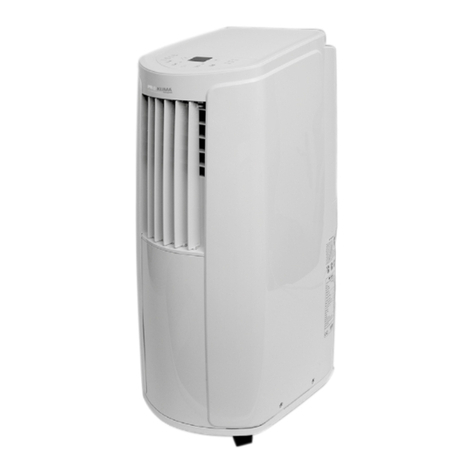
ProKlima
ProKlima GPC10AL User manual
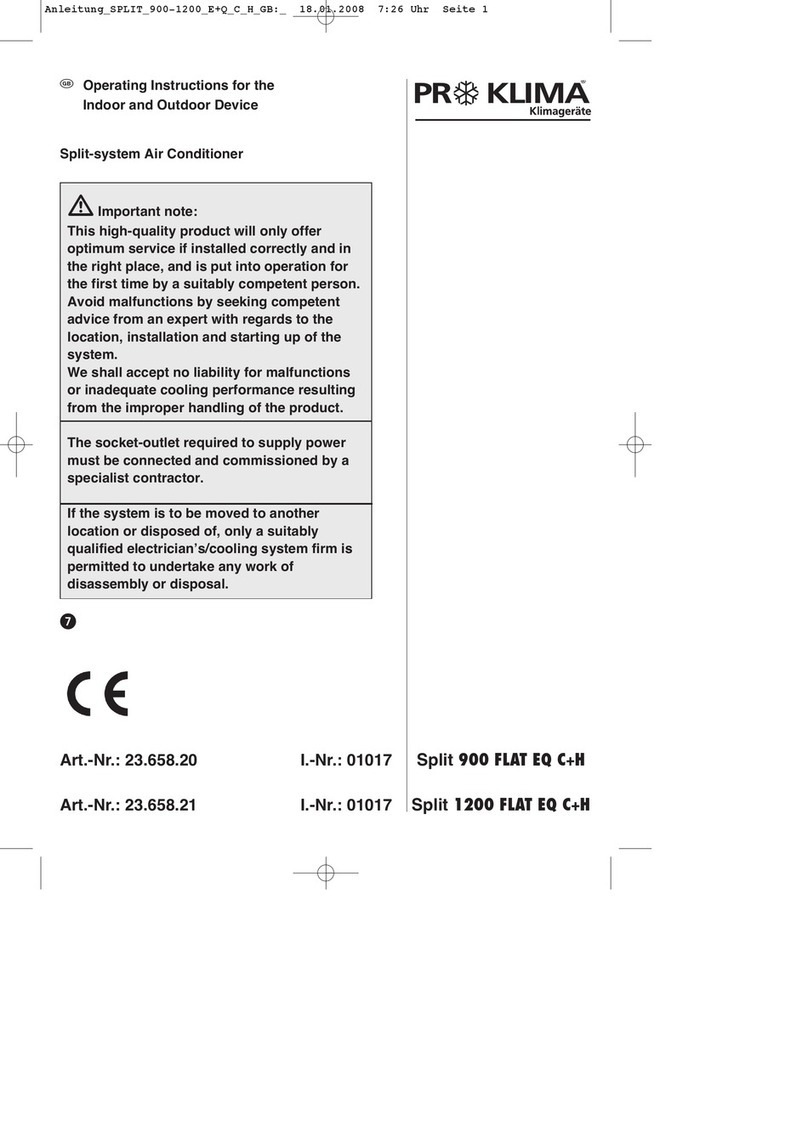
ProKlima
ProKlima Split 900 FLAT EQ C+H User manual
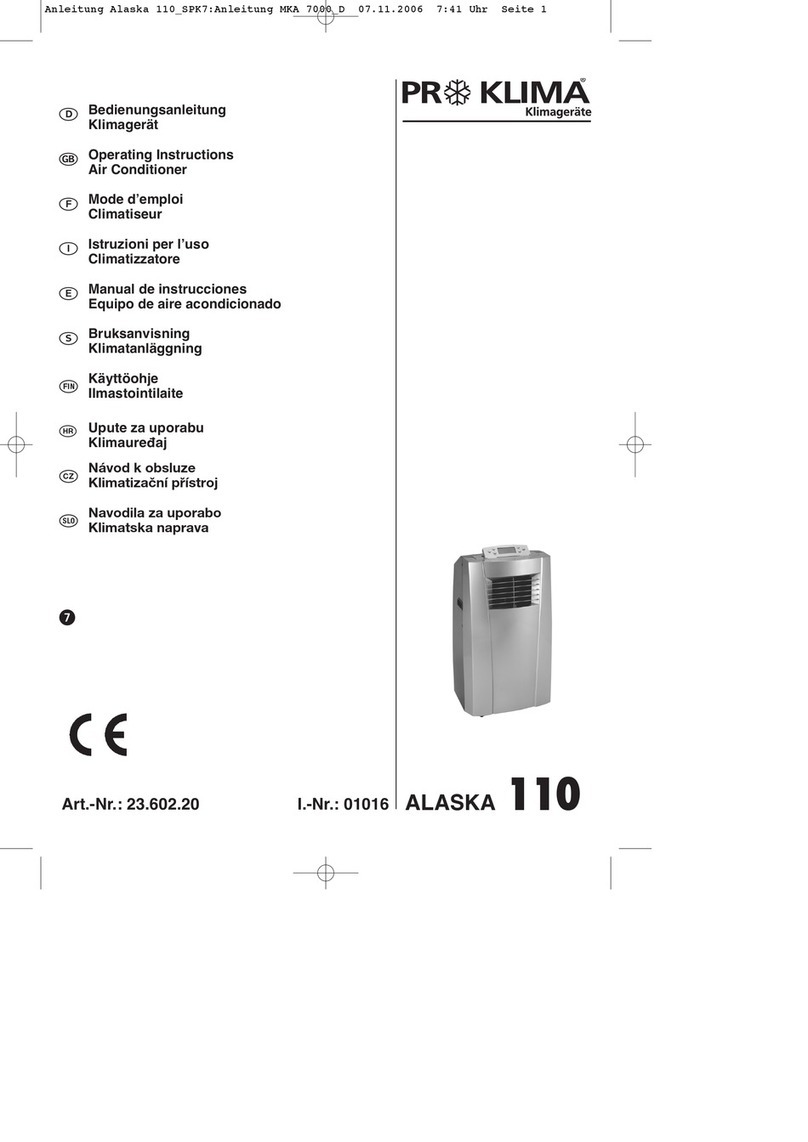
ProKlima
ProKlima ALASKA 110 User manual
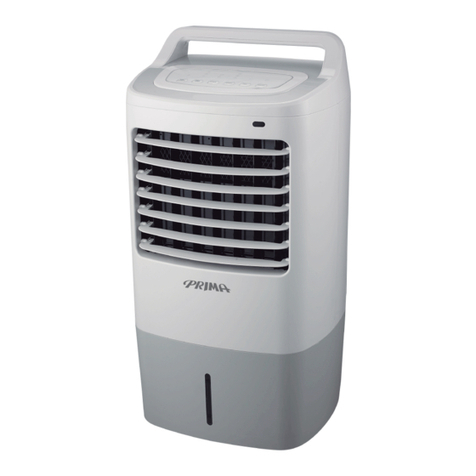
ProKlima
ProKlima AC120-16AR User manual

ProKlima
ProKlima GPC12AJ User manual
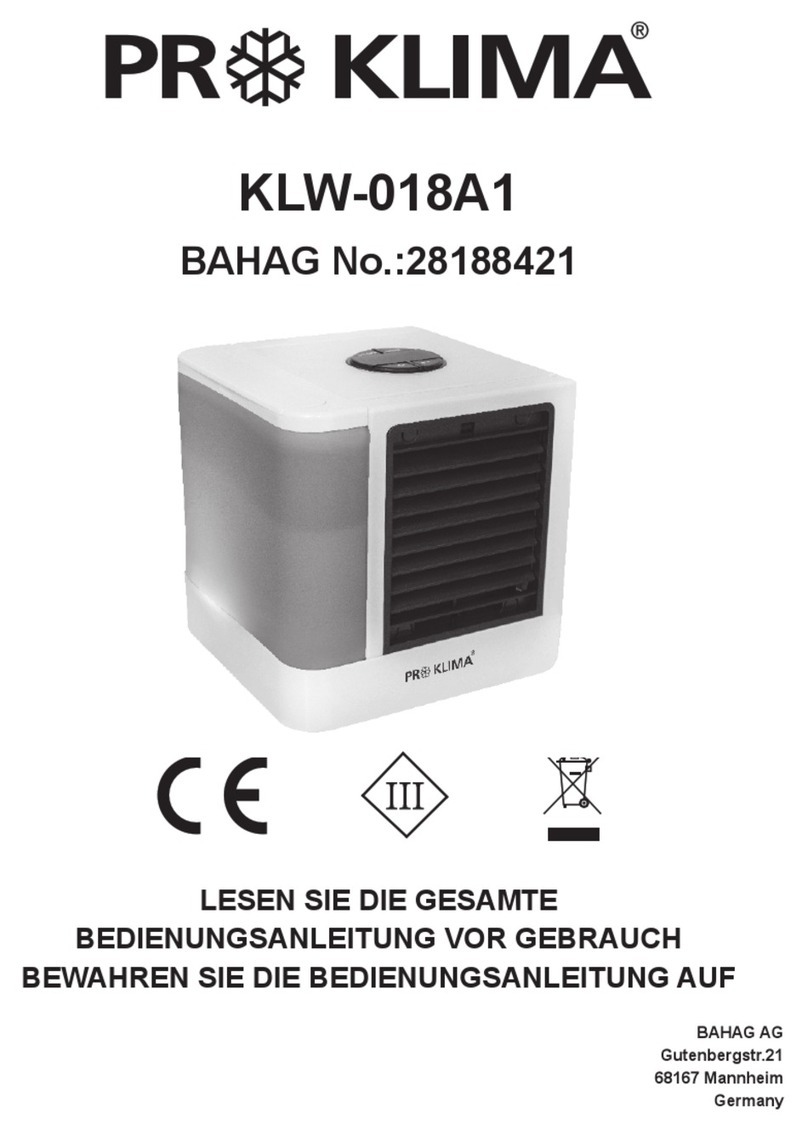
ProKlima
ProKlima KLW-018A1 User manual
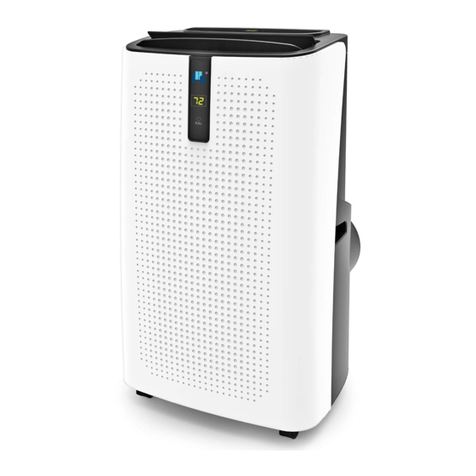
ProKlima
ProKlima JHS-A018 -12KR2/C-W User manual

ProKlima
ProKlima A018A-09C-PLUS-W User manual
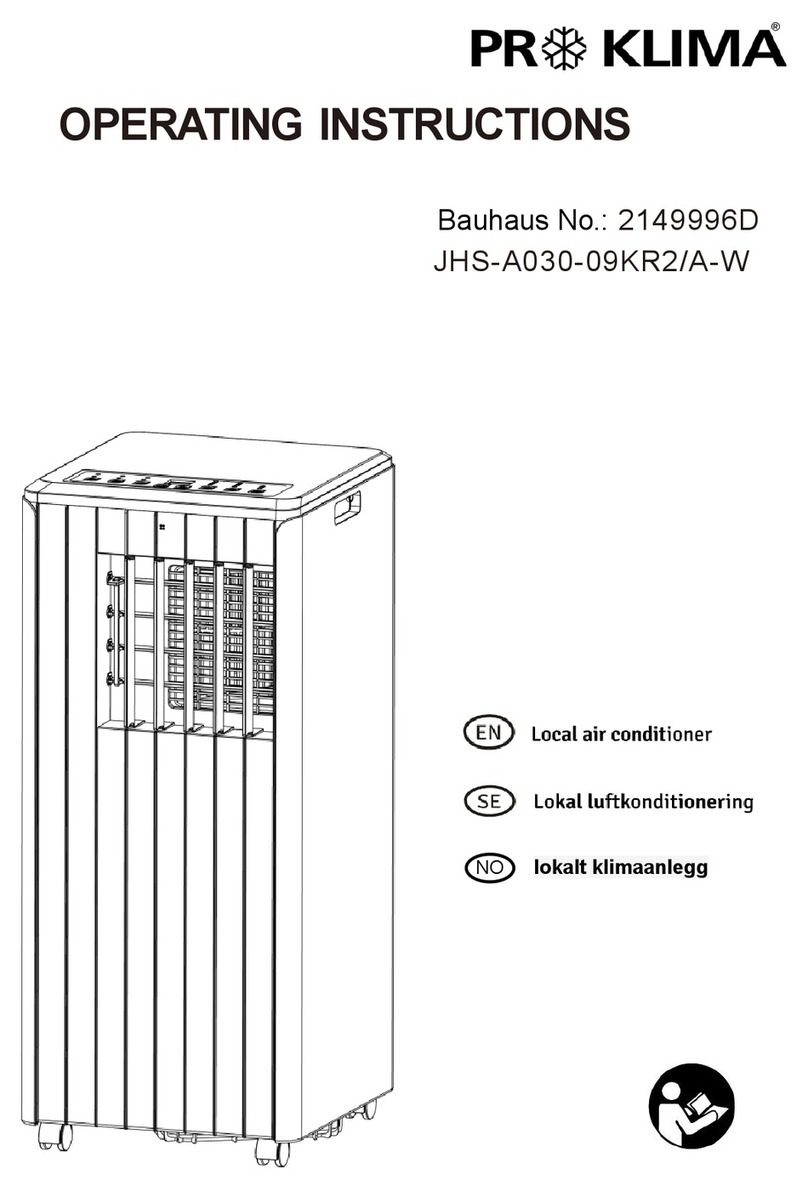
ProKlima
ProKlima JHS-A030-09KR2/A-W User manual
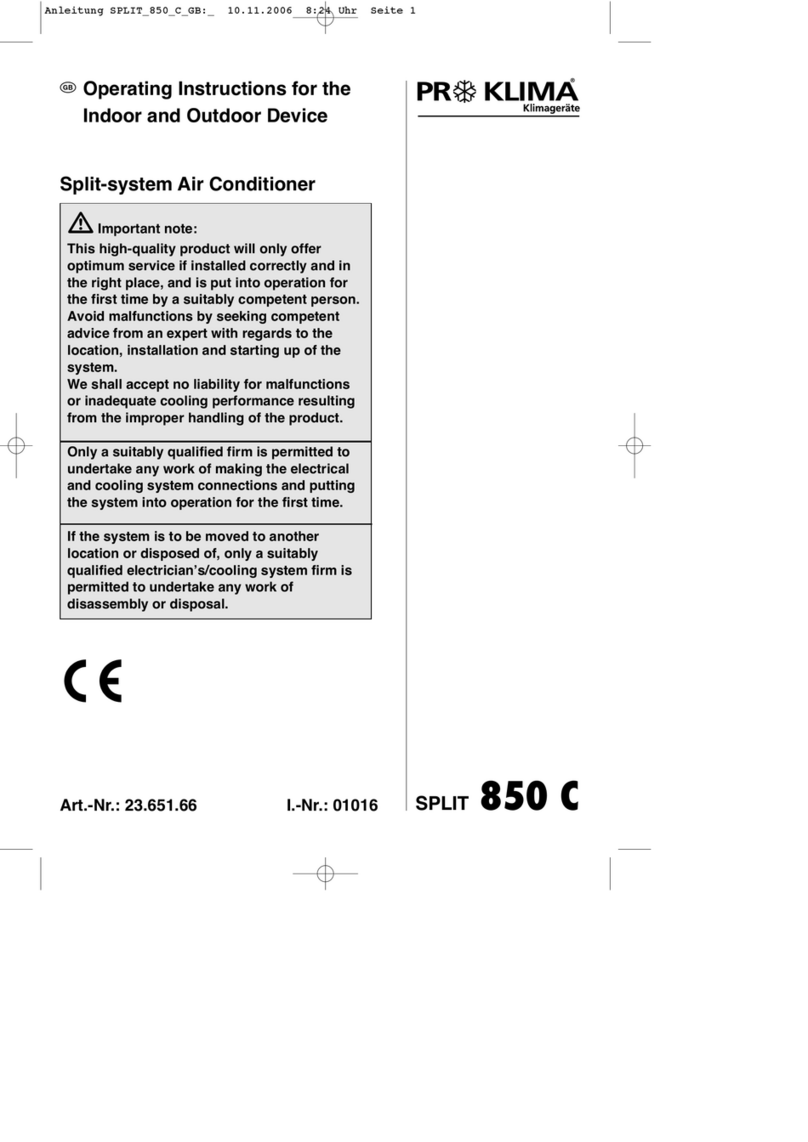
ProKlima
ProKlima SPLIT 850 C User manual
